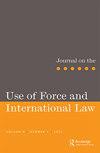Introduction
Q3 Social Sciences
Journal on the Use of Force and International Law
Pub Date : 2018-01-02
DOI:10.1080/20531702.2018.1455416
引用次数: 0
Abstract
This issue of the Journal on the Use of Force and International Law (JUFIL) begins with another excellent guest editorial comment, this time by Alexander Orakhelashvili. In his comment, Orakhelashvili critiques the approach that has been taken by the High Court in England and Wales in relation to the crime of aggression. The articles section of this issue then comprises four pieces that, while taking very different points of focus, touch on some similar underlying themes related to states’ legal argumentation and invocation of the law in the ad bellum context, and possible disconnects between the status of law (whether perceived or actual) and what states may say or do. The issue’s first article, by Christian Marxsen, takes as a starting point the apparent contradiction between states’ verbal commitments to the law and the prevalence of armed conflicts. He provides empirical insights into how states invoke international law to justify their uses of force, and develops a typology of how law can be confirmed by its invocation – even in cases where it may be coupled by illegal action – through an inductive approach based on case-analysis. The second article in this issue is a contribution by Christina Nowak, who uses intervention in civil wars as a lens through which to examine the complexities of legal argumentation in the ad bellum context. She uses state practice to show that states employ a spectrum of reasoning and argumentation adjusted to the political, moral or strategic relevance of the issue in question, and argues that emphasis should be placed on an ‘in-between stage’ of quasi-legality in which states test, reformulate or reject potential new legal arguments. Graham Melling’s contribution to the issue focuses on the Responsibility to Protect (R2P) doctrine, and considers whether the considerable degree of prominence of R2P within international discourse may be at odds with its emergence (or lack of) as an international norm with the capacity to influence and shape the decision-making of states. Finally in this section, Victor Kattan argues that there has been an attempt to expand the scope of the right of self-defence, and particularly the right of anticipatory self-defence through the provision of a new standard of ‘imminence’. In so doing, his arguments centre more on the process of development of the legal arguments rather than the arguments themselves, with a notable – although not exclusive – focus on the Principles Relevant to the Scope of a State’s Right of Self-Defense Against an Imminent or Actual Armed Attack by Nonstate Actors published by Sir Daniel Bethlehem in the American Journal of International Law in 2012.介绍
本期《使用武力与国际法杂志》(JUFIL)以亚历山大·奥拉赫拉什维利(Alexander Orakhelashvili)的另一篇出色的客座评论开始。在他的评论中,Orakhelashvili批评了英格兰和威尔士高等法院对侵略罪所采取的方法。本期的文章部分由四篇文章组成,虽然侧重点非常不同,但触及了一些类似的潜在主题,这些主题与国家在战时背景下的法律论证和援引法律有关,以及法律地位(无论是感知的还是实际的)与国家可能说或做的事情之间可能存在的脱节。这期杂志的第一篇文章由克里斯蒂安·马克思森(Christian Marxsen)撰写,以各国对法律的口头承诺与武装冲突的普遍存在之间的明显矛盾为出发点。他提供了关于国家如何援引国际法来证明其使用武力的合理性的经验见解,并通过基于案例分析的归纳方法,发展了一种法律如何通过援引国际法来确认的类型学-即使在可能与非法行为相结合的情况下。本期的第二篇文章是克里斯蒂娜·诺瓦克的贡献,她以干预内战为视角,审视战时背景下法律论证的复杂性。她使用国家实践来表明国家采用一系列的推理和论证来适应问题的政治,道德或战略相关性,并认为重点应该放在准合法性的“中间阶段”,在这个阶段,国家测试,重新制定或拒绝潜在的新的法律论点。格雷厄姆·梅林对这一问题的贡献集中在保护责任(R2P)原则上,并考虑了R2P在国际话语中相当突出的程度是否可能与它作为一种具有影响和塑造国家决策能力的国际规范的出现(或缺乏)相矛盾。在本节的最后,维克多·卡坦认为,人们一直试图通过提供一种新的“迫在眉睫”标准来扩大自卫权利的范围,特别是预期自卫权利。在此过程中,他的论点更多地集中在法律论点的发展过程上,而不是论点本身,并特别关注丹尼尔·伯利恒爵士(Sir Daniel Bethlehem) 2012年在《美国国际法杂志》(American Journal of International Law)上发表的《关于国家对非国家行为体即将或实际武装攻击的自卫权范围的相关原则》(尽管并非唯一)。
本文章由计算机程序翻译,如有差异,请以英文原文为准。
求助全文
约1分钟内获得全文
求助全文
来源期刊

Journal on the Use of Force and International Law
Social Sciences-Law
CiteScore
1.10
自引率
0.00%
发文量
13
 求助内容:
求助内容: 应助结果提醒方式:
应助结果提醒方式:


